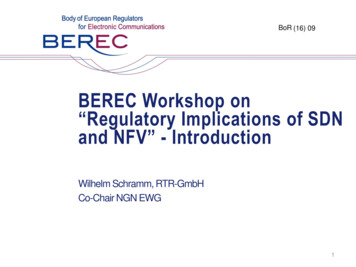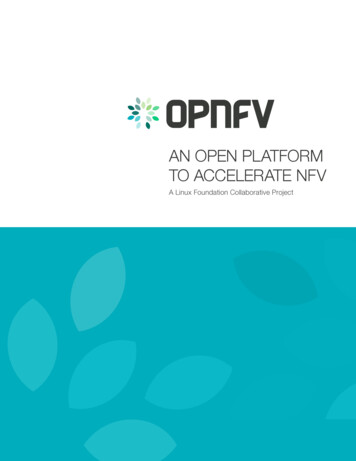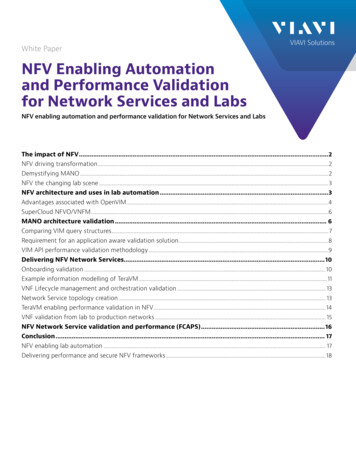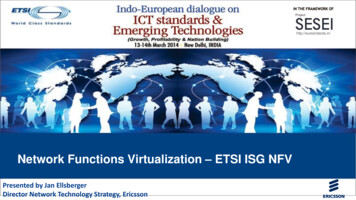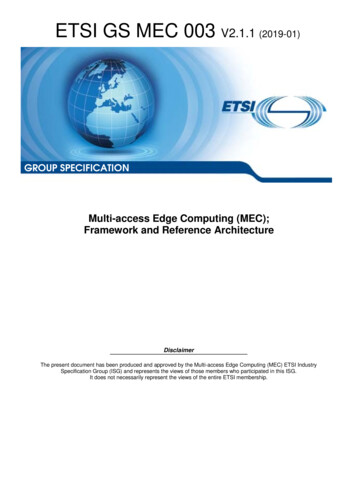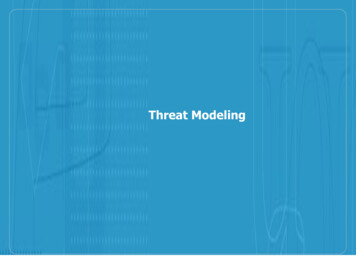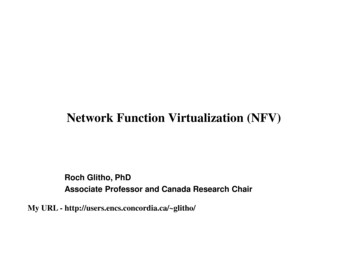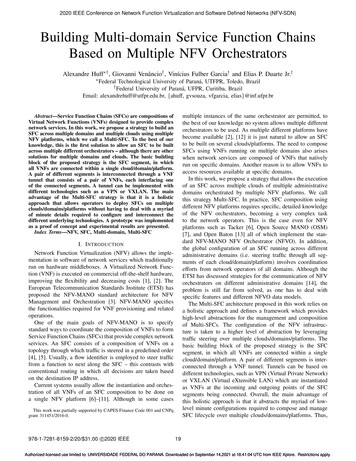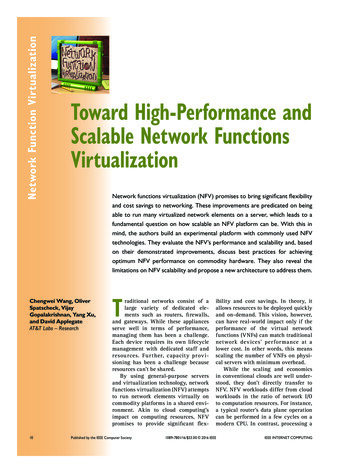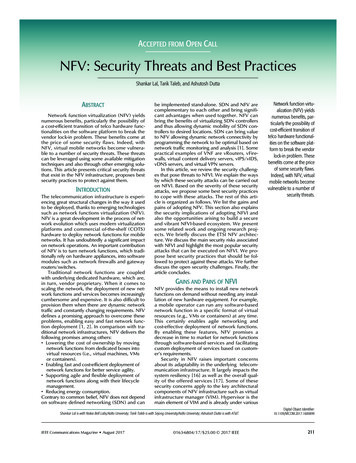
Transcription
Accepted from Open CallNFV: Security Threats and Best PracticesShankar Lal, Tarik Taleb, and Ashutosh DuttaAbstractNetwork function virtualization (NFV) yieldsnumerous benefits, particularly the possibility ofa cost-efficient transition of telco hardware functionalities on the software platform to break thevendor lock-in problem. These benefits come atthe price of some security flaws. Indeed, withNFV, virtual mobile networks become vulnerable to a number of security threats. These threatscan be leveraged using some available mitigationtechniques and also through other emerging solutions. This article presents critical security threatsthat exist in the NFV infrastructure, proposes bestsecurity practices to protect against them.IntroductionThe telecommunication infrastructure is experiencing great structural changes in the way it usedto be deployed, thanks to emerging technologiessuch as network functions virtualization (NFV).NFV is a great development in the process of network evolution which uses modern virtualizationplatforms and commercial of-the-shelf (COTS)hardware to deploy network functions for mobilenetworks. It has undoubtedly a significant impacton network operations. An important contributionof NFV is to turn network functions, which traditionally rely on hardware appliances, into softwaremodules such as network firewalls and gatewayrouters/switches.Traditional network functions are coupledwith underlying dedicated hardware, which are,in turn, vendor proprietary. When it comes toscaling the network, the deployment of new network functions and services becomes increasinglycumbersome and expensive. It is also difficult toprovision them when there are dynamic networktraffic and constantly changing requirements. NFVdefines a promising approach to overcome theseproblems, enabling easy and fast network function deployment [1, 2]. In comparison with traditional network infrastructures, NFV delivers thefollowing promises among others: Lowering the cost of ownership by movingnetwork functions from dedicated boxes intovirtual resources (i.e., virtual machines, VMsor containers). Enabling fast and cost-efficient deployment ofnetwork functions for better service agility. Supporting agile and flexible deployment ofnetwork functions along with their lifecyclemanagement. Reducing energy consumption.Contrary to common belief, NFV does not dependon software defined networking (SDN) and canbe implemented stand-alone. SDN and NFV arecomplementary to each other and bring significant advantages when used together. NFV canbring the benefits of virtualizing SDN controllersand thus allowing dynamic mobility of SDN controllers to desired locations. SDN can bring valueto NFV allowing dynamic network connectivity byprogramming the network to be optimal based onnetwork traffic monitoring and analysis [1]. Somepractical examples of VNF are vRouters, vFirewalls, virtual content delivery servers, vIPS/vIDS,vDNS servers, and virtual VPN servers.In this article, we review the security challenges that pose threats to NFVI. We explain the waysby which these security attacks can be carried outon NFVI. Based on the severity of these securityattacks, we propose some best security practicesto cope with these attacks. The rest of this article is organized as follows. We list the gains andpains of adopting NFV. This section also explainsthe security implications of adopting NFVI andalso the opportunities arising to build a secureand vibrant NFVI-based ecosystem. We presentsome related work and ongoing research projects. We briefly discuss the ETSI NFV architecture. We discuss the main security risks associatedwith NFVI and highlight the most popular securityattacks that can be executed on NFVI. We propose best security practices that should be followed to protect against these attacks. We furtherdiscuss the open security challenges. Finally, thearticle concludes.Network function virtualization (NFV) yieldsnumerous benefits, particularly the possibility ofcost-efficient transition oftelco hardware functionalities on the software platform to break the vendorlock-in problem. Thesebenefits come at the priceof some security flaws.Indeed, with NFV, virtualmobile networks becomevulnerable to a number ofsecurity threats.Gains and Pains of NFVINFV provides the means to install new networkfunctions on demand without needing any installation of new hardware equipment. For example,a mobile operator can run any software-basednetwork function in a specific format of virtualresources (e.g., VMs or containers) at any time.This certainly enables agile networking andcost-effective deployment of network functions.By enabling these features, NFV promises adecrease in time to market for network functionsthrough software-based services and facilitatingcustom deployment of services based on customer’s requirements.Security in NFV raises important concernsabout its adaptability in the underlying telecommunication infrastructure. It largely impacts thesystem resiliency [16] as well as the overall quality of the offered services [17]. Some of thesesecurity concerns apply to the key architecturalcomponents of NFV infrastructure such as virtualinfrastructure manager (VIM). Hypervisor is themain element of VIM and is already under variousShankar Lal is with Nokia Bell Labs/Aalto University; Tarik Taleb is with Sejong University/Aalto University; Ashutosh Dutta is with AT&T.Digital Object Identifier:10.1109/MCOM.2017.16008990163-6804/17/ 25.00 2017 IEEE211IEEE Communications Magazine August 2017
-GWvPCEFSGiInternet,cloud services,partnersVirtualizedIMSHypervisorCommon hardware (COTS)SDNeNodeBeNodeBeNodeBMobile devicesLTE(smartphones,RANM2M, IoT)Related Work and Ongoing ProjectsFigure 1. NFVI- DDoS resiliency.NFV managment and orchestrationOs-MaOSS/BSSNFVorchestratorOr-VnfmEM 1EM 2EM 3VNF 1VNF 2VNF )Service, tualnetworkVirtualization layerVl-HaHardware iFigure 2. The ETSI NFVI reference architecture.1 ity Home212on demand. In this scenario, an attacker couldcreate a botnet army by infecting many mobiledevices with a “remote-reboot” malware, enablingthe attacker to instruct the malware to reboot alldevices at the same time (step 1 in Fig. 1). Thesimultaneous rebooting of all devices causesexcessive “malicious” attach requests and resultsin a signaling storm (step 2 in Fig. 1), puttingvMME under DDoS attack. In response to theattack, the orchestrator may instantiate a newVM to scale-out the vMME function to sustain thesurge in the signaling traffic and to ensure serviceavailability while the attack is being investigated(step 3 in Fig. 1).security attacks such as VM/guest OS manipulation and data exfiltration/destruction. Therefore,when the hypervisor is compromised, other vulnerabilities can arise exponentially. Since NFVdelivers software enabled automated provisioningof network functions, it can also open securityvulnerabilities such as automated network configuration exploits, orchestration exploits, maliciousmisconfiguration, and SDN controller exploits.Due to the elastic and flexible nature of NFVI elements, some security attacks can also becomeamplified. One type of such an attack is called aDNS amplification attack, which is discussed ina later section. In addition, VNFs are likely to beprovided by many different vendors, which canpossibly result in interoperability issues causingsecurity loopholes in the infrastructure [3].In addition to these security risks, the flexibleand scalable nature of NFV helps to improve theincident response time, provides better resiliency against distributed denial of service (DDoS)attacks and enables on-demand firewalling andintrusion detection/prevention systems (IDS/IPS) to block or reroute malicious traffic. Figure 1depicts an example of an attack on NFVI. In theenvisioned scenario, the mobility managemententity (MME) is virtualized and the orchestratoris capable of instantiating new vMME instancesSecurity concerns have been raised in [4] wherethe authors identified security challenges in managing security of virtual appliances in cloud serviceprovider’s infrastructure along with the introduction of additional entities such as orchestratorswhich can be vulnerable to security threats. Theauthors in [5] presented two security risks thatneed to be taken care of during NFV design. Thefirst is the isolation and protection of two networkfunctions from different subscribers. The second isthe security and resiliency of physical and virtualresources of NFVI. In [6], the authors provided asecurity framework for virtualized networks basedon the use of a root trusted module.There are a number of ongoing researchprojects in the NFV security domain aiming toprovide security and resiliency of the NFV infrastructure. The European H2020 Arcadia project1has the objectives of detecting, exploring, andunderstanding security events in NFVI by servicechain performance analytics to detect anomalistic behavior of the network functions. The 5GEnsure project2 envisions securing future 5G networks that will rely on NFVI. It aims at developing security enablers consisting of privacy, trust,and virtualization isolation functions for 5G networks. OPNFV, an open source project from theLinux Foundation3, has a dedicated security groupworking on vulnerability management to developnetwork security functions for NFV.Brief Overview of NFV InfrastructureNFVI provides the infrastructure that consists ofall the hardware and software resources that arerequired to deploy VNFs. Figure 2 shows the NFVIreference architecture as defined by the Europeantelecommunications standards institute (ETSI). Thehardware resources consist of compute, storage,and network elements that basically provide theprocessing, storage, and connectivity capabilitiesto VNFs through a virtualization layer. The virtualization layer provides an abstraction to the hardware resources and enables the software to usethe virtualized infrastructure instead. Examplesof the virtualization layer are the hypervisor andcontainer based virtualization solutions such asDocker. Beyond the NFVI, the NFVI architecturalframework also includes the following functionalbuilding blocks [7].Virtual Network Functions: VNFs are softwarepackages that can implement the network functions using the infrastructure provided by NFVI.Virtualizing the network functions reduces hardware usage, improves the scalability, and reducesIEEE Communications Magazine August 2017
implementation costs. This enables easy upgrades,reduced power consumption, and equally reducedmaintenance.NFV Orchestrator: Responsible for onboarding the new network services and their lifecycle(e.g., instantiation, scaling in and out, performancemeasurement, and termination). The NFV orchestrator also performs global resource managementand authorization to resource requests in the NFV.VNF Manager(s): In charge of lifecycle management of VNFs from instantiating, updating,scaling, and terminating, and also performingother functions that are necessary for the entireVNF lifecycle. It also performs coordination andevent reporting to other NFVI components.Virtual Infrastructure Manager(s) (VIM): TheVIM functionality includes controlling and managing the interaction of VNFs with NFVI. Basically, itperforms resource management, which involvesmanagement and allocation of NFVI resourcessuch as compute, storage, and network resourcesto VNFs. It also analyzes the performance of NFVIand logs if there is any fault information. Otherfunctions of VIM involve collecting and forwarding performance and measurement events.Additionally, there exists a VNF descriptor(VNFD) in the NFV management and orchestration stack, which is a VNF deployment templateand contains descriptions regarding VNF operational and deployment requirements.Security Risks Associated with NFVVNFs run over virtual resources such as VMs. Thesecurity threats associated with VNFs are the combination of the security threats on physical networkingand on virtualization technologies where NFV specific threats emerge when the two sets of threatsintersect each other [8]. In the following, we discussthe potential security risks associated with NFVI,considering some potential attack scenarios.Isolation Failure RiskHere, we consider the case when an attackermanages to break into a hypervisor by compromising some VNFs running over it. This attack canimpose great risk once successfully carried out.This is called a VM escape attack and is depictedin Fig. 3. In this attack scenerio, the attacker firstcompromises one VNF by gaining access to itsoperating system (step 1 in Fig. 3). Using toolsand VNF network connectivity with the cloudmanagement network, the attacker gains accessto the hypervisor management API (step 2 in Fig.3) and then the attacker breaks into the hypervisor to cause great impact (step 3 in Fig. 3). Theseattacks are possible due to the improper isolation between hypervisors and VNFs. A practicalexample of this attack could be launched by anapplication, running in a VNF and sending craftednetwork packets in order to exploit heap overflowwith a compromised virtualization process andresulting in the execution of arbitrary code on thehypervisor to gain access to the host.In another attack scenario, a VNF may orchestrate other VNFs, which can be achieved bygranting the VNF API access to the virtualizationinfrastructure to instantiate new VNFs. The APIcan be misused by an attacker who can break inby compromising the VNF and gaining full accessto all infrastructure resources [9].IEEE Communications Magazine August 2017VNF1VNF2ApplicationVNF3ApplicationApplication ApplicationAttacker1OSOSOSVMtoolsVMtoolsHypervisor (VMM)VMtools32Managements APIsPhysical hardwareFigure 3. A VM escape attack scenario.Network Topology Validation andImplementation FailureUsing NFV, virtual networking components (e.g.,virtual routers and virtual networks) can be easily created. Quick and dynamic service decisionscan result in human error when a virtual routeris created and used to interconnect virtual networks without the use of any firewall. Comparedto physical network appliance deployments, thedynamicity of virtual network appliances and itsconnectivity can lead to improper separationbetween the network and its subnets. Using theabove mentioned VM escape attack, an attackercan compromise virtual firewalls to restrict firewall functionality while allowing enough access tocarry out the attack. In a similar attack scenario,an attacker may acquire knowledge about a multisite network infrastructure using the elastic natureof NFVI. Effectively, an attacker can trigger theVNF instantiation or migration in another NFVIpoint of presence with lower security protection(i.e., without any IDS/IPS/deep packet inspection(DPI) capabilities) [9].Regulatory Compliance FailureAttacks aiming to place and migrate workloadoutside the legal boundaries were not possibleusing traditional infrastructure. Using NFV, violation of regulatory policies and laws becomes possible by moving one VNF from a legal location toanother illegal location, as depicted in Fig. 4. Theconsequences of violating regulatory policies canbe in the form of a complete banning of serviceand/or exerting a financial penalty, which maybe the original intention of the attacker to harmthe service provider. One possible attack scenariocan be when an attacker exploits the insecureVNF API to dump the records of personal datafrom the database to violate user privacy.Denial of Service Protection FailureDoS attacks may be directed to virtual networksor VNFs’ public interfaces to exhaust networkresources and impact service availability. A hugevolume of traffic from a compromised VNF canbe generated and sent to other VNFs that wouldbe running on the same hypervisor or even ondifferent hypervisors. Similarly, some VNF applications can consume high CPU, hard disk, and213
Malicious InsiderVNF location shiftattackAttackerSGSN/GGSNLocation USAHLRRNCLocation UKLocation RussiaVNFaaSVNFVNFVNFHosting service providerVNFVNFVNFVNFVNFVNFVNF tenantsNFVIaaSNFVI providerIaaSNaaSNaaSPaaSPaaSNFV Best Security PracticesSaaSFigure 4. VNF location shift CRFvS-GW vP-GW vPCEFSGIVictimCommon hardware (COTS)eNodeBeNodeBMobile devices eNodeB(smartphones,LTEM2M, IoT)RANInternet,cloud igure 5. DNS amplification attack.memory resources in order to exhaust the hypervisor [9]. In this vein, Fig. 5 depicts one practicalscenario of DNS amplification attack. In this scenario, a NFVI infrastructure hosts a virtual DNSserver as a component of a virtual evolved packet core (vEPC). The NFVI orchestrator is ableto deploy additional virtual DNS servers if thetraffic load increases. An attacker may spoof IPaddresses of a number of victims and launchesa high number of malicious DNS queries usingthe spoofed IP addresses (step 1 in Fig. 5). Inresponse to such an attack, the orchestrator willinstantiate new VMs to scale-out the vDNS function to accommodate more queries (step 2 inFig. 5). Accordingly, multiple recursive DNS servers will respond to the victims that will ultimatelyreceive amplified DNS query responses (step 3in Fig. 5), which can result in its service disruption or unavailability.Security Logs Troubleshooting FailureIn this security attack, compromised VNFs cangenerate a huge amount of logs on the hypervisor,making it difficult to analyze logs from other VNFs,especially when the initial entries in the log filesare deleted. There is also risk when the infrastructure logs are leaked, which consequently enablescross relating of logs from one VNF operator withanother to extract sensitive information [10].214These risks are classified as internal security risksand are caused by vicious actions of internaladministrators. In one attack scenario, a malicious administrator takes the memory dump of auser’s VM. Since the malicious administrator hasthe root access to the hypervisor and by usinga search operation, they can extract the userID, passwords, and SSH keys from the memorydump, which in turn violates user privacy anddata confidentiality. In a second attack scenario,an internal attacker may extract a user’s data fromthe hard-drive volume, managed by the cloudstorage devices. To execute this attack, the attacker first creates a backup copy of the VM driveand then uses open source tools, such as kpartxand vgscan, to extract sensitive data from it [11].In this section, we shed light on best security practices that should be followed in order to achievereasonably better security protection against theabove mentioned threats in a NFV environment. Itshould be noted that these practices do not guarantee foolproof security of NFVI, but will providebetter resiliency against these threats.Boot Integrity Measurement Leveraging TPMUsing trusted platform module (TPM) as a hardware root of trust, the measurement of systemsensitive components such as platform firmware,BIOS, bootloader, OS kernel, and other systemcomponents can be securely stored and verified.The platform measurement can only be takenwhen the system is reset or rebooted; there is noway to write the new platform measurement inTPM during the system run-time. The validation ofthe platform measurements can be performed byTPM’s launch control policy (LCP) or through theremote attestation server [12]Hypervisor And Virtual Network SecurityThe hypervisor enables virtualization betweenunderlying hardware and VMs. Virtual networks inthe cloud use SDN to enable connectivity amongVMs and also with outside networks. Securityof these elements is a must in order to protectthe whole infrastructure [15]. One of the security best practices is to keep the hypervisor up-todate by regularly applying the released securitypatches. Failure to do that would result in exposure to security risks in the future. Another bestpractice is to disable all services that are not inuse. For example, SSH and remote access service may not be needed all the time; therefore,it would be a good idea to enable these servicesonly when needed [13]. Cloud administrators arethe gatekeepers of the whole infrastructure andtheir accounts are the keys. It should be mandated to secure admin accounts by applying a strongpassword policy along with strictly following anorganization’s security guidelines.Security ZoningTo prevent a VM from impacting other VMs orhosts, it is a good practice to separate VM trafficand management traffic. This will prevent attacksby VMs tearing into the management infrastructure. It is also a good idea to separate the VLANtraffic into groups and disable all other VLANsIEEE Communications Magazine August 2017
that are not in use. Likewise, VMs of similar functionalities can be grouped into specific zones andtheir traffic should be isolated. Each zone can beprotected using access control policies and a dedicated firewall based on its needed security level.One example of such zones is a demilitarizedzone (DMZ) [13, 15].after system reboot. This enables an attack scenario whereby a VM swap is copied and investigated to retrieve any useful information. Oneway to avoid this kind of attack is to encrypt VMswap areas. Linux based tools such as dm-cryptcan be used for this purpose [10].Linux Kernel SecurityIt is easy to tamper with VNF images. It requiresonly a few seconds to insert some malware intoa VNF image file while it is being uploaded toan image database or being transferred from animage database to a compute node. Luckily, VNFimages can be cryptographically signed and verified during launch time. This can be achieved bysetting up some signing authority and modifyingthe hypervisor configuration to verify an image’ssignature before they are launched [9].In virtualized platforms, the kernel of the hostsystems is a highly important component thatprovides isolation between the applications. TheSELinux module, developed by the National Security Agency (NSA), is implemented in Kernel andprovides robust isolation between the tenantswhen virtualization technology is used over thehost. Secure virtualization (sVirt) is a new formof SELinux, developed to integrate mandatoryaccess control security with Linux based hypervisors. sVirt provides isolation between VM processes and data files. Beyond these tools, otherkernel hardening tools can be useful to secure theLinux kernel. A notable example is hidepd, whichcan be used to prevent unauthorized users fromseeing other users’ process information. Anotherexample is GRSecurity, which provides protectionagainst attacks on corrupted memory [10].Hypervisor IntrospectionHypervisor introspection can be used to scrutinize software running inside VMs to find abnormal activities. It acts as a host-based IDS that hasaccess to the states of all VMs, so that the root kitand boot kit inside VMs cannot hide easily. Usingintrospection capabilities, the hypervisor’s functionalities are enhanced, enabling it, among otherthings, to monitor network traffic, access files instorage, and read memory execution. Hypervisorintrospection APIs are powerful tools to performdeep VM analysis and potentially increase VMsecurity. However, they can also be used as anexploit that makes it possible to break and bypassthe isolation between VMs and the hypervisor.LibVMI is the library for hypervisor introspectionfor various platforms, implemented in C languagewith Python bindings. It gives the hypervisor themeans to perform deep inspection of VMs (e.g.,memory checking, vCPU register inspection, andrecording trapping events) [14].Encrypting VNF Volume/Swap AreasVirtual volume disks associated with VNFs maycontain sensitive data. Therefore, they need tobe protected. The best practice to secure theVNF volume is by encrypting them and storingthe cryptographic keys at safe locations. TheTPM module can also be used to securely storethese keys. In addition, the hypervisor shouldbe configured to securely wipe out the virtualvolume disks in the event a VNF is crashed orintentionally destroyed to prevent it from unauthorized access [6]. VM swapping is a memorymanagement technique used to move memorysegments from the main memory to disk, whichis used as a secondary memory in order toincrease system performance in case the systemruns out of memory. These transferred memory segments can contain sensitive informationsuch as passwords and certificates. They can bestored on the disk and remain persistent evenIEEE Communications Magazine August 2017VNF Image SigningSecurity Management and OrchestrationTo prevent a VM fromimpacting other VMsor hosts, it is a goodpractice to separate VMtraffic and managementtraffic. This will preventattacks by VMs tearinginto managementinfrastructure. It is alsoa good idea to separatethe VLAN traffic intogroups and disable allother VLANs that arenot in use.One best practice consists of designing a NFVorchestrator incorporating security and trustrequirements of the NFVI. The orchestrationand management of security functions requiresintegration by enabling interaction among thesecurity orchestrator, the VNF manager, and theelement management systems (EMS). This typeof protection can be achieved by setting scaling boundaries in the VNFD or network servicedescriptor (NSD), for example, and having theNFVO enforce these restrictions to protect fromattacks such as a DNS amplification attack.Remote AttestationThe remote attestation technique can be usedto remotely verify the trust status of a NFV platform. The concept is based on boot integrity measurement leveraging TPM, as mentioned earlier.Remote attestation can be provided as a service,and may be used by either the platform owner ora consumer to verify if the platform has booted ina trusted manner [12]. Practical implementationsof the remote attestation service include the opencloud integrity tool (openCIT), an open sourcesoftware hosted on GitHub.Table 1 provides a summary of the securityrisks associated with NFVI as discussed above,and lists the targets of these risks along with possible mitigation techniques.Open Security ChallengesDespite the best practices described above, thereare still open security challenges that are yet tobe addressed. One of the security challenges isto define the standard interface in the ETSI NFVarchitecture to deploy virtual security functionsto react to various threats in real time. Such functionalities should be able to communicate withthe orchestration modules and follow the provided instructions. Another challenge is to securely manage and monitor VNFs by maintainingtheir configuration and state information duringmigration. This can be difficult to perform due tothe dynamicity and elasticity of VNF operationsin cloud environments. Another challenge is toperform the trust management between differentvendors who build NFV hardware and software.The challenge is to efficiently manage the trustchain among vendors and provide trustiness ofthe final VNF products.215
Security riskTargetBest practices1CompromisedhypervisorPlatformSeparation of VM and management traffic,regular hypervisor patching2Isolation failurePlatform/VNFsHypervisor introspection, security zoning3Platform integrityPlatformTPM boot integrity, remote attestation4DDoS attackVNFsFlexible VNF strategic deployment to defendagainst DDoS5Malicious insiderVNFsVolume/swap encryption, VNF image signing,strict operational practices6Regularity compliancefailureVNFsGeo-tagging using remote attestationTable 1. NFVI security risks and best practices.At the moment, attestation technologies onlyprovide the boot time attestation. This does notguarantee run time modification or prevent tampering with the system’s critical components,and such modification would only be detectedwhen the system is rebooted. Run time attestation is still an open research area that needs tobe explored further. There is also a strong needto develop a comprehensive security architecture to take care of these security challenges inNFVI. To achieve these goals, network operatorsand vendors need to work together to form avibrant security ecosystem. New standards, testbeds, and proofs of concept would serve as acatalyst for securing the NFV infrastructure. Theservices in this new virtualized environment arerapidly evolving, and in turn create new opportunities for innovation.ConclusionNFV undoubtedly provides great benefits for telecom service providers in terms of cost efficiencyand dynamic service deployability. However, it isextremely necessary to understand the securityimplications for these benefits. It is essential toknow the difference between general cloud computing infrastructure and NFV infrastructure and itsneeds and requirements. Previous studies presented analysis on security threats that exist in cloudcomputing along with mitigation techniques. It isequally required that similar studies have to becarried out for security in NFVI. Indeed, NFVIhosts highly sensitive workloads, and accordinglyneeds to be highly secured and protected. In thisarticle, we identified security attacks on NFVI. Wealso presented best security practices to protectagainst these attacks. Admittedly, security in NFVIis still in its infancy, and there are still many opensecurity challenges to tackle. This defines oneof the future research directions of the authors.Future work also includes putting into practice theproposed solutions by means of implementationsand experimental testbed setups.AcknowledgementThis article is issued within the research activitiesof the Finnish Dimecc Cyber Trust Program. Itwas also partially supported by the ANASTACIAproject, which
that exist in the NFV infrastructure, proposes best security practices to protect against them. IntroductIon The telecommunication infrastructure is experi-encing great structural changes in the way it used to be deployed, thanks to emerging technologies such as network functions virtualization (NFV). NFV is a great development in the process .
